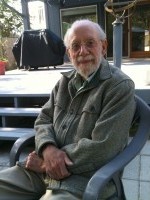
One of the first climbers to reach the summit of Mount McKinley from the South Buttress route is back in Alaska to tell his story. George Argus reached the peak with a team of men in 1954. He nearly didn’t make it back alive.
Sitting outside on a summer day in Anchorage, George Argus wears the same coat that got him through that six-week ordeal. And it’s in pretty good condition.
“That’s because I’m an economical fellow. I don’t throw away anything.”
Argus was wearing the coarse, woolen coat when he began his trip up Mount McKinley on April 17, 1954. He was with two other members of the University of Alaska Alpine Club, Elton Thayer and Les Viereck. Morton Wood was also part of their team.
“I had climbed, but pretty small things. I had never been on an expedition like this before.”
It took more than a month for the team to make it to the base of McKinley’s south buttress. Discovering hard ice instead of the soft snow that they had expected, the team worked to chip out steps in the ice, slowly making their way up the face of the peak, one hard-fought inch at a time. Reaching the top of that wall on May 9th, they were able to see the summit. Six days later, the four men stood at the highest point in North America.
“And from there on, it was downhill.”
And the descent did deteriorate quickly. Elton Thayer was last on the rope that held the four men together, and while descending below the crest of the area known as the Coxcomb, Thayer slipped, taking the rest of the team with him in a fall of nearly 1,000 feet. When the men finally came to a halt after Les Viereck was wedged into a crevasse, Elton Thayer was dead and George Argus had a dislocated hip.
After it was clear that Argus would not be able to make the descent, Viereck and Wood pulled him down to an area better protected from the snow storms. Argus was wrapped up in his sleeping bag and dragged behind the two men.
“But we got to a place where I was hanging upside-down and it was really hurting my hip. I called out “What are you guys doing?” Something like that. Of course, they didn’t reply, and they got me down. It was only years later that Les said, ‘You know that time you were upside down? We weren’t sure if we could hold onto you.’ Gulp.”
Argus was left behind while Wood and Viereck trudged the rest of the way down the mountain to get help for him. Alone for a week and in great pain, Argus kept himself occupied by carefully rationing out his supplies. And his book, a collection of short stories by Mark Twain.
“At the end, when I was waiting to be found again, I would read this book again, but I’d read one page, and then I would close the book and lie back and close my eyes. And then I’d open it up again and read one more page, because to stretch it out the time, the only way you could do it was read slowly.”
By the time a crew made it to Argus a week later, he still had a few supplies left, offering to make tea for his rescuers. He says he heard later from Wood and Veireck how treacherous the rest of their trip down the mountain had been.
“Yeah, I have a lot of debt to these people. A lot of debt.”
It took three months for Argus’s hip to heal. In the half-century since that trip, he has been in the mountains, but never really been climbing again.
Argus will be giving a presentation about his climbing experience at the Anchorage Museum Auditorium Monday night at 7: 00 p.m.
Download Audio (MP3)
Heather Aronno is an intern for APRN for the Spring 2012 semester. She has previously completed an internship for APRN in the summer of 2011, and is Strategic Communications Major at University of Alaska Anchorage. A transplant from the lower 48, Heather has lived in Anchorage, Alaska since the summer of 2005. Fortunately, it was a nice summer, and she's considered Alaska her home ever since.




